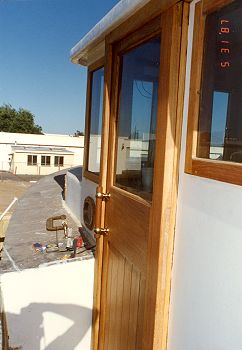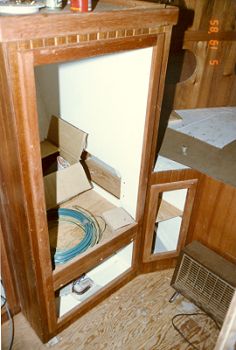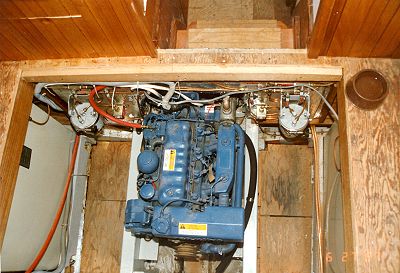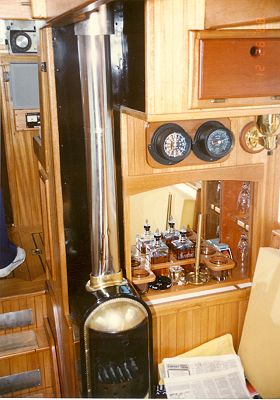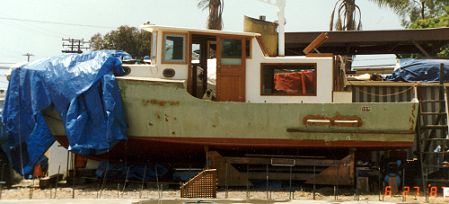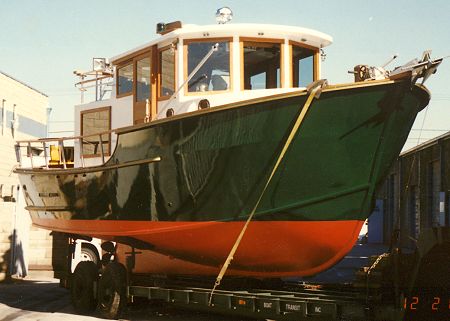Salty
by James A. Simpson
The following was dated 31 August 1988. There were several more pages, listing specific equipment, which have not been included. Mr. Simpson obviously did a tremendous amount of preparation for what was to be the voyage of a life time. Unfortunately, we heard no further reports about the trip."Salty" is about as small of a trawler type boat that can be built and still carry full life support systems for 2-4 people for extended periods of time/range.
She is somewhat of a "Gatsby Period" style having a boxy or squared off cabin, raised forward deck, a pilot house, an aft cabin, and walk-around side/aft deck. A small trunk cabin sits just forward of the pilot-house.
She was designed by Glen-L Marine as the "Jolly Roger", which was about 28' long. In the "Salty" version that is discussed here, she is 31'10" down the center, not counting the bow plank, or swimstep, which adds another 3-1/2' to her overall length. (LOA=35.5')
She has been heavily constructed. All exterior wood is teak, including the cabin soles. All other interior wood is tongue and groove mahogany. All exterior surfaces were given several coats of epoxy undercoat and then 3 coats of L.P, over several ply of Fiberglass.
Power is supplied by a single screw Perkins 4-108 of 50 HP (36 Cont. shaft HP) driving a 20X14" four blade prop through a 2.91:1 reduction gear. She has a design cruising speed of about 7.5 kts. at S/L = 1.4, and should be using about 25 SHP. However, for long range use, she will cruise at about 6-6.5 kts., which puts her at S/L = 1.1 for 6 kts. and reduces the engine RPM to close to 1800 RPM. producing around 8 SHP.
The intended mission for Salty is to travel from Southern California to the San Juan Islands area. After exploring that region, travel on northward through the Inside Passage to Alaska, with several side trips into some of the off-beat places.
From Alaska we plan to travel back south to the Seattle area, then back down the West Coast to the Panama Canal (if it's still there) and then over to Florida. We will then most likely cruise the Caribbean islands and part of the Intercostal Waterway. This is quite an undertaking in such a modest boat.
The reason for so much equipment on such a small boat is the above mission that is planned and the remote locations. It is mandatory that the vessel be as well equipped and offer life support for at least 4 people for extended periods.
The extensive electronics is due to the extreme remote areas of Canada and Alaska we will be in for extended periods of time. We must also stay in touch with family and friends. In addition, if we would ever need medical help, we would first have to be able to contact land based help. The Fax is for weather pictures (to see what's heading our way). The SITOR (telex) & HAM is less expensive to use on a per minute basis than voice.
Salty will be in areas for upward to 1-1/2 to 2 years where it gets quite cool, therefore the need for the furnace. The fireplace is ok for looks and roasting a few marshmallows but for real comfort, we feel we need a good furnace and I think a 40,000 BTU unit should work ok since we always have the fireplace as a backup. The engine heaters would normally be used only while underway.
The house battery system centers around two 12V banks of 350 A.H, batteries. This size is picked so we may remain at anchor for up to 48 hrs. without having to recharge batteries. We use one bank on even number days and the other bank on odd number days, always switching each day.
With up to 700 A.H. to recharge we need a good heavy duty alternator. Our standard auto type alternator won't do since most of them are rated for maybe 70 Amps or so and really can't put out that kind of power for any length of time due to temperature buildup. Therefore Salty carries a heavy duty alternator which can produce up to 130 Amps continuous up to 200F.
There is also the matter of the Voltage Regulator. The one that normally comes with an engine is a auto type and is a constant voltage type rather than a constant current type, which is ok for cars but can't hack it too well for boats who have 700 AMPS to put back in to the house batteries. (Actually we will never discharge the house batteries below about 50% point 12.4V.) At any rate we want to pump a lot of current into the batteries rather quickly say over 3-4 hours.
Enter the Tri-State Regulator-this device controls the charging rate to the batteries and the output from the alternator. In addition, it can also measure battery voltage to two places past the decimal and can read the current being used under normal conditions. As a backup to this device we also carry a normal electronic voltage regulator. The A.C. generator is also equipped with a standard 70 amp alt. that is also controlled by the tri-state regulator and would normally be used when at anchor and running the diesel generator. Of course, it will take longer as its output is not as great as the 130 amp unit.
There are two reasons for two Ref/Frz compressors. One is so we will have a backup in case of failure of the other unit. Keep in mind, the deep freeze may contain several hundred dollars of meat and food. The other reason for the two compressors is some of the 30 Amp dock supplies can't start a 1/2 HP compressor. In that case, we use the 1/3 HP unit dockside and the 1/2 HP when under way where we have sufficient capacity from the onboard AC generators to start the 1/2 HP. That's in addition to all the other AC loads, except for the hot water heater, which we normally use the diesel furnace to heat the hot water with. We do, however, use the AC heater in the hot water heater when we are dockside. Our normal compressor time for 24 hours for the Ref. & Frz. is about 22 min. per day for the Ref. at 33 degrees and just under 2 hours per day for the Freezer, when set for -5 to -15 degrees F.
Computers and Software-A small lap-top MS-DOS computer plays an important part in every day functions aboard Salty. It is used for all the normal things such as word processing, spread sheets, etc. However, one or two of its major uses is to keep track of all the various databases we keep. In addition it is a part of our communication equipment. As an example of the various databases we keep, one is for all the charts we carry, their chart number, the scale, the area they cover etc. Another database keeps track of the food inventory, another the ships inventory of such things as major items, spares, where they are stored, date purchased, cost, and any model or serial numbers. Still another keeps track of all the weather fax frequencies and time schedules.
We also use the computer as a Telex machine using SITOR, radio teletype, (for news, weather, sports and even the Dow Jones closing) FAX or weather maps.
I have one other project yet to do with the computer and that's to interface its serial port to the Magnavox 4102 SATNAV so we can use the computer to both update the SatNav waypoints and to printout position fixes, in addition to storing routes on the disk for review at a later date.
Performance
I have enclosed copies of some of Salty's performance projections. These are shown by speed, S/L, and SHP, along with two separate fuel capacities. One is for the two main tanks and one for all fuel capacity including the aux tanks which are normally used for the generator and the diesel furnace.
We have charts for various weights, the ones shown are for 14,000 lbs. or 6.25 long tons.
In conclusion, I hope all this work planning and preparation is worth it, since I have spent the last 6-1/2 years building this boat and another two to three years planning it and this cruise.
